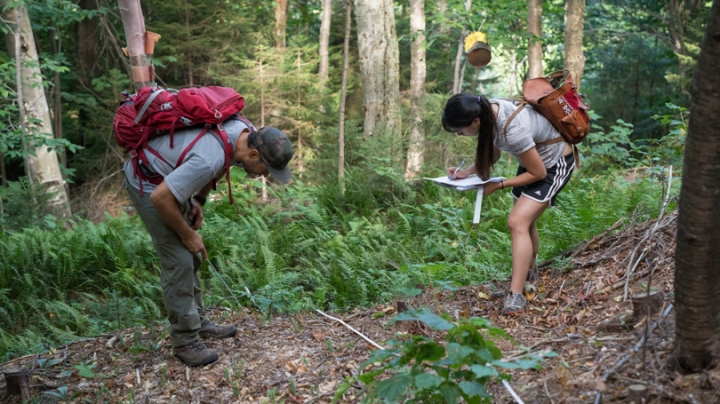In recent years, some backcountry skiers and snowboarders have been cutting their own trails through wooded areas, sometimes illegally and without permission from landowners. The unfortunate results: erosion, the destruction of wildlife habitat, and damage to plant species.
In an effort to prevent such damage in the Green Mountain National Forest (GMNF), the Environmental Studies Program is teaming up with forest managers and the Rochester Area Sports Trails Alliance (RASTA) on an unprecedented two-year pilot project in Brandon Gap, near Rochester, Vt.
Beginning last fall, RASTA volunteers, with members of the Catamount Trail Association and about a dozen Dartmouth students, cleared trees and brush to create four tracks—backcountry skiers call them “lines”—from the base to the top of the mountain. Using chainsaws and hand tools, the trail makers followed guidelines established by the GMNF with input from Nicholas Reo, an assistant professor of environmental studies and Native American studies.
“We want to make trails that steer away from sensitive areas, like bear dens, wetlands, and endangered plant species. Our goals are to create trails that are fun to ski and to not cause any significant ecological impacts in the process. Dartmouth’s role is to monitor the forest ecosystem and meet with trail users to assess whether we achieve these dual goals,” says Reo. This is a pilot project, and Dartmouth’s research effort will help the U.S. Forest Service decide whether and how to continue with this type of backcountry ski project in the future.
Last winter, there wasn’t enough snow for backcountry skiers to use the trails safely. So it’s hard to know yet whether the project is striking a balance between outdoor recreation and environmental protection. As the research progresses, Brandon Gap continues to provide Dartmouth’s Environmental Studies Program with an outdoor classroom. One of the students helping to determine how the new trails are changing vegetation on the mountain is Kang-Chun (“KC”) Cheng ’17.
“I like measuring the vegetation at various elevations,” Cheng says. “We monitor tree density and count shrubs and herbaceous plants, and just get an overall look, so we can compare what we find to last year’s data. We also observe how many plants appear to have been browsed—munched on by animals. You cut these trails, and you get more sunlight coming in, possibly new kinds of growth, and we want to know how that affects mammals feeding on them.” On a recent sunny morning, Cheng joined Reo, RASTA volunteer Karl Fjeld, and GMNF District Recreation Program Manager Holly Knox on a hike to gather data on the trails.
Gathering in the Bear Brook parking lot at the base of the mountain, the group talked about their ongoing work to assess environmental impact of the project. Reo says forest plants and animals are slow to react to brush and tree cutting, so it’s too early to draw conclusions about the effects on the ecosystem.
“But on the human side, we’ve already learned a lot,” he says. “We were able to rally a large group of volunteers and they actually followed our cutting principles, which was a challenge. I was worried that they’d get in there and get to work and lose track of how we’re trying to do this. But I’ve been really impressed by how well people have stuck to the prescription.”
Knox, of GMNF, is also pleased with the progress of the woodland experiment. “There were people who were concerned about whether we should do this project, and I think to have the reputation of Dartmouth behind it, and the knowledge that comes with having them partner with us, will help us continue to do this kind of work, based on solid science.” As backcountry skiing and snowboarding surge in popularity, Knox says, “It’s really essential that we understand the impact of managing for this kind of use in the forest.”
And for Cheng, hiking up a mountain on a picture-perfect morning was not a bad way to spend a day. She and other students who participate in this project are learning how to monitor forest ecosystems for unintended consequences of backcountry skiing. They are also seeing what a career in resource management might look like, as they partner with non-profit organizations and the Forest Service.
Cheng hopes the Brandon Gap collaboration will be a model for others, not only in Vermont, but throughout the nation. “It’s better to give skiers and snowboarders a sense of support, so they won’t do something illicit,” she says. In the Green Mountains, at least, “they’ll know that people are trying to help them and even improve the conditions for their hobby—and also make them aware of the sensitivity of the forest.”

